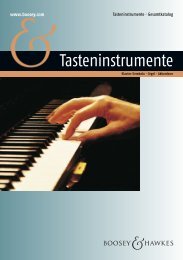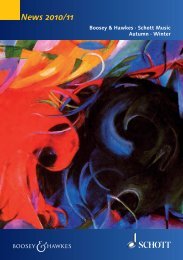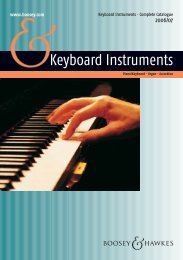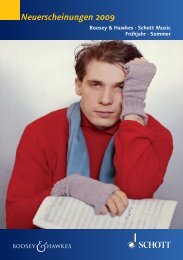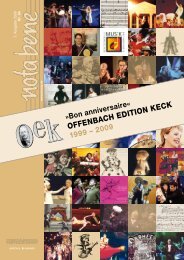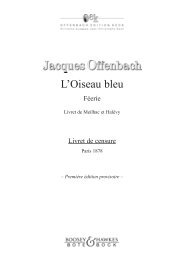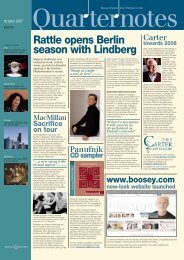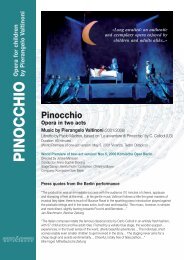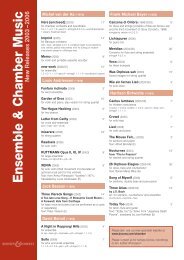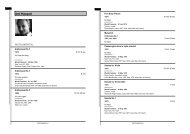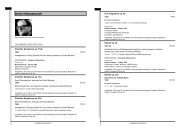New Composers Rachmaninoff
New Composers Rachmaninoff
New Composers Rachmaninoff
You also want an ePaper? Increase the reach of your titles
YUMPU automatically turns print PDFs into web optimized ePapers that Google loves.
June 2008<br />
2008/2<br />
Included in this issue:<br />
Andriessen<br />
Interview exploring opera<br />
on Dante’s Commedia<br />
Cherubini<br />
Award-winning edition in<br />
Vienna and Brussels<br />
Marsalis<br />
Leading jazz composers<br />
sign new contracts<br />
Rautavaara<br />
Tapestry of Life premiere<br />
and new CDs<br />
Birtwistle The Minotaur<br />
Harrison Birtwistle’s<br />
thrilling new opera reveals<br />
the half-man, half-beast<br />
As the Sunday Times noted at the Covent<br />
Garden premiere on 15 April, “Harrison<br />
Birtwistle’s latest opera is a piece he might<br />
have been expected to write. The Minotaur, to<br />
words by David Harsent, was commissioned<br />
by the Royal Opera House and premiered<br />
there under Antonio Pappano, and is like a<br />
summary of Birtwistle’s preoccupations.<br />
Greek mythology has rarely been far from his<br />
thoughts. Monstrous beings such as the<br />
Minotaur have regularly featured in his<br />
operas… and labyrinths such as the one<br />
Daedalus made for King Minos, to cage the<br />
Minotaur, have provided Birtwistle with a<br />
principle of form.”<br />
“The most powerful and<br />
original opera yet to have<br />
emerged this century.”<br />
The Scotsman<br />
“Blood-drenched and sorrowful, majestic and raw,<br />
The Minotaur plunders the extremes of human<br />
nature in music of coruscating, storming beauty…<br />
Low woodwind, sensuous strings and the spangly<br />
clatter of the cimbalom colour the orchestra in<br />
sombre, glistening tones. The rewards are at once<br />
unsettling and exhilarating… the applause, though<br />
deserved by all, was primarily for yet further proof<br />
of Birtwistle’s epic creative clarity.” Evening Standard<br />
“…in the Minotaur himself, a role specially<br />
conceived for the bass John Tomlinson, Birtwistle<br />
has created one of his most complex and<br />
fascinating protagonists… It is a dramatic tour de<br />
force for Tomlinson, who handles it superbly and<br />
gives eloquence to a creature who can articulate<br />
Photo: Bill Cooper<br />
his thoughts only in his dreams, and acquires the<br />
power of speech only after the fatal blow has<br />
landed.” The Guardian<br />
“The moment when the beast stands revealed is a<br />
brilliant coup de théâtre. The drama is now both<br />
wonderful and dreadful; as more victims are raped<br />
and gored, blood upon blood, the crowd intones<br />
a drugged and ecstatic chorale brutally shattered<br />
by a screeching chorus of winged furies. Here the<br />
music’s crazy momentum displays Birtwistle’s<br />
talents at magnificently full stretch… the evening is<br />
a glittering success.” The Independent<br />
“He is such a master of orchestration – he<br />
constantly takes the ear to new places, producing<br />
brilliant colours. And no one knows better how to<br />
build a tension, hold it, resolve it. There is hugely<br />
impressive writing for the slaughter of the<br />
innocents, shriek upon shriek cutting a swathe<br />
through the orchestra. Elsewhere, keening high<br />
brass over strings and low brass produces a<br />
mesmerizing effect. The work is broken by three<br />
orchestral toccatas, again with hauntingly beautiful<br />
material.” Opera America<br />
Boosey & Hawkes Music Publishers Limited<br />
John Tomlinson as The Minotaur in Birtwistle's opera at the Royal Opera House, Covent Garden.<br />
<strong>New</strong> <strong>Composers</strong><br />
Qigang<br />
Chen b.1951<br />
Enrico<br />
Chapela b.1974<br />
Boosey & Hawkes is pleased<br />
Mexican composer Enrico<br />
to announce a publishing<br />
Chapela has signed a<br />
contract with Chinese<br />
publishing agreement with<br />
composer Qigang Chen, who<br />
Boosey & Hawkes covering<br />
this year directs the music at<br />
his existing output and future<br />
the opening ceremony of the<br />
works. Chapela is one of the<br />
Beijing 2008 Olympic Games.<br />
most exciting young talents<br />
The new agreement covers Chen’s future to emerge from Latin America, with a<br />
compositions, while his earlier works remain growing number of international<br />
published by Billaudot and Durand.<br />
performances and commissions. Current<br />
Qigang Chen was studying music as a<br />
teenager at the Central Conservatory of<br />
Music at the outbreak of the Cultural<br />
Revolution in 1966. He was confined for<br />
three years and underwent “ideological reeducation”,<br />
yet went on learning composition<br />
despite social and political anti-cultural<br />
pressures. In 1977 the state reopened entry<br />
to the Conservatory and he studied there for<br />
five years with Luo Zhongrong.<br />
In 1983 Chen won a postgraduate contest to<br />
travel abroad, and for four years was<br />
Messiaen’s only student after the master’s<br />
retirement from the Paris Conservatoire. He<br />
described how Chen’s compositions “show<br />
real inventiveness, very great talent and a total<br />
assimiliation of Chinese thinking with<br />
European musical concepts.” Chen has<br />
received commissions from Radio France,<br />
Deutsche Kammerphilharmonie, Stuttgart<br />
RSO, Orchestre Symphonique de Montréal<br />
and the Koussevitzky Foundation. He was<br />
composer-in-residence at the Strasbourg<br />
Philharmonic from 2004 to 2006.<br />
projects include a rock trio concerto for the<br />
Dresden Sinfoniker for premiere in<br />
September, a new work for the NYDD<br />
Ensemble in Tallinn, and a commission from<br />
the Los Angeles Philharmonic for<br />
performance in the Green Umbrella new<br />
music series in 2009.<br />
Chapela studied guitar and composition at<br />
the Centro de Investigación y Estudios de la<br />
Música in Mexico City, and has combined<br />
activities as a guitarist with further studies at<br />
the University of Paris at St Denis. His<br />
musical style fuses different geographic<br />
traditions and musical soundworlds, so that<br />
contemporary techniques happily coexist<br />
with minimalist, jazz or rock idioms. This<br />
dialogue of cultures is not ‘world music’, but<br />
rather a place where jam sessions can meet<br />
complex metrical games, where the anarchic<br />
drive of favela buskers can collide with the<br />
chants of football fans.<br />
Chapela’s symphonic poem Ínguesu has<br />
travelled widely since its premiere by the<br />
Carlos Chavez Symphony Orchestra in<br />
2003, including a North American tour last<br />
Works that have travelled internationally autumn by the Philharmonic Orchestra of<br />
include Iris devoilée (2001) for orchestra, the Americas. The Dallas <strong>New</strong>s described<br />
female voices and Chinese instruments, how the work “transmutes the cheers and<br />
available on a highly successful Virgin<br />
jeers of the 1999 Mexico vs. Brazil soccer<br />
Classics disc (7243 5 45549 2 6), and Raise match into an Ivesian collage of chatter,<br />
the Red Lantern (2002), a full-evening ballet blast and slide.” The work can be heard on<br />
for National Ballet of China directed by a CD Baby disc entitled Antagónica,<br />
Zhang Yimou. Future projects include an together with the saxophone quartet La<br />
orchestral work for the Hong Kong<br />
Mengambrea and Lo Nato es Neta for rock<br />
Philharmonic and a second ballet.<br />
trio and acoustic quintets.<br />
Photo: Frank Harders<br />
Photo: Peter Joslin/ArenaPAL<br />
“The music begins like flowing magma, muffled<br />
and dark, forming itself frequently à la Alban Berg<br />
into a lengthy adagio... A few times there is<br />
opportunity for excessive, indeed explosive visions<br />
of sound using the powerful range of percussion,<br />
particularly in depicting the murderous acts of the<br />
beast… Even the end of the Minotaur is dazzlingly<br />
reaffirmed in this manner… Compared with<br />
somewhat fussy myth adaptations such as Ulisse<br />
by Dallapiccola or some of Henze’s late works,<br />
Birtwistle demonstrates absolutely the hand of a<br />
heady, heavyweight storyteller-in-sound.”<br />
Frankfurter Rundschau<br />
“It is that rare beast –<br />
a successful new opera.”<br />
Bloomberg <strong>New</strong>s<br />
With the premiere of The Minotaur and two<br />
productions of Punch and Judy, London<br />
was the epicentre of Birtwistle attention this<br />
spring. The operatic focus shifts abroad later<br />
in the year with the Italian premiere of The<br />
Last Supper as part of a Birtwistle feature at<br />
Settembre Musica in Turin and Milan<br />
(4-11 September), and the German premiere<br />
of The Io Passion at the Berlin Kammeroper<br />
(7-16 November).<br />
Mackey<br />
in Manchester<br />
The music of Steven<br />
Mackey is celebrated in<br />
Manchester between 16<br />
and 18 June, with 13 of his<br />
works performed across<br />
three days. The Spring-<br />
Loaded event combines<br />
concerts by Psappha, the<br />
BBC Philharmonic and<br />
students at the Royal Northern College of<br />
Music. Highlights include the UK premieres<br />
of Measures of Turbulence for eight guitars<br />
and of the electric cello concerto<br />
Banana/Dump Truck with its dedicatee Fred<br />
Sherry as soloist. Also in the final orchestral<br />
concert, conducted by Clark Rundell, are<br />
Lost and Found, Turn the Key and Eating<br />
Greens, offering a showcase of Mackey’s<br />
exuberant and zany style.<br />
Mackey is currently completing a violin<br />
concerto, Beautiful Passing, commissioned<br />
by the BBC and Saint Louis Symphony for<br />
Leila Josefowicz, which promises to travel<br />
through both antagonistic and tranquil<br />
territories. HK Gruber conducts the world<br />
premiere in Manchester with the BBC<br />
Philharmonic on 24 October and David<br />
Robertson the US premiere performances in<br />
Saint Louis on 14 and 15 November.<br />
Mackey describes how “the governing<br />
metaphor of the concerto has to do with the<br />
violin gaining control of its own destiny,<br />
competing with, commanding and ultimately<br />
letting go of the orchestra. This metaphor<br />
arises from my experience, during the<br />
composition of the piece, watching my<br />
mother gain control of her destiny to the<br />
point of predicting the day she would let go,<br />
predicting the day of her death. Her last<br />
words to me were: “Please tell everyone I<br />
had a beautiful passing”.<br />
<strong>Rachmaninoff</strong><br />
concerto from symphony<br />
This autumn brings the first concert<br />
performance of a new arrangement of<br />
<strong>Rachmaninoff</strong>’s Symphony No.2,<br />
transformed into a three-movement piano<br />
concerto with a duration of 42 minutes.<br />
<strong>Rachmaninoff</strong> was himself ranked among an<br />
elite group of expert piano transcribers<br />
together with Liszt, Godowski and Busoni,<br />
and the new arrangement by Russian-born<br />
performer and composer Alexander<br />
Warenberg similarly aims to recast this<br />
much-loved orchestral music into a form for<br />
performance by virtuoso pianists.<br />
The Paris premiere of Piano Concerto “No.5”<br />
at the Salle Pleyel on 21 November features<br />
<strong>Rachmaninoff</strong> specialist Denis Matsuev and<br />
the Orchestra Philharmonique de Radio<br />
France conducted by Vladimir Spivakov. The<br />
all-<strong>Rachmaninoff</strong> programme, presented in<br />
collaboration with the Serge <strong>Rachmaninoff</strong><br />
Foundation, also includes Symphonic<br />
Photo: Alice Arnold<br />
Dances and Matsuev performing the recently<br />
rediscovered Suite in D minor and Fugue in<br />
D minor, as heard on his acclaimed Sony<br />
BMG recording (88697155912).<br />
The initial idea to create Piano Concerto<br />
“No.5” came from record producer Pieter<br />
van Winkel who was responsible for its first<br />
recording on Brilliant Classics (8900) with<br />
soloist Wolfram Schmitt-Leonardy, the<br />
Janá÷ek Philharmonic Orchestra and<br />
Theodore Kuchar. A reviewer in FonoForum<br />
praised the skill and sensitivity of<br />
Warenberg’s arrangement:<br />
“With the exception of occasional small<br />
retouchings, Warenberg leaves<br />
<strong>Rachmaninoff</strong>’s tonal language, his melody,<br />
style of writing and instrumentation,<br />
untouched. And in the newly-added solo<br />
part, he demonstrates a perfect sensitivity for<br />
the work with his characteristic piano writing.<br />
It sounds from beginning to end like “real”<br />
<strong>Rachmaninoff</strong>. All in all, Warenberg must be<br />
credited with having perfectly assimilated<br />
<strong>Rachmaninoff</strong>’s sound world, and he has<br />
succeeded in creating a concerto not only<br />
based on his music, but also in his style.”<br />
The Serge <strong>Rachmaninoff</strong> Foundation is<br />
supporting a project by the BBC<br />
Philharmonic under Gianandrea Noseda to<br />
reassess the composer’s Symphony No.1,<br />
scarred for a century since its disastrous<br />
premiere in 1897. A new Chandos recording<br />
is released this month and the orchestra<br />
presents the symphony on 11 August within<br />
the BBC Proms’s <strong>Rachmaninoff</strong> feature. All<br />
three symphonies can be heard in the<br />
London Symphony Orchestra’s<br />
<strong>Rachmaninoff</strong> weekend conducted by Valery<br />
Gergiev (20-21 September).
Photo: Matt Stuart<br />
Andriessen La Commedia<br />
Louis Andriessen discusses his new opera, premiered in Amsterdam on 12 June.<br />
When was your interest in Dante’s La<br />
Commedia first kindled?<br />
I’ve had an ongoing interest in Dante<br />
for close on 30 years. At the time of<br />
writing De Tijd I was researching<br />
possible texts in Florence. The work<br />
finally ended up using a text by St<br />
Augustine, but I did retain as a motto<br />
a phrase from the Paradiso section of<br />
Commedia that describes “gazing on<br />
the point beyond which all times are<br />
present”.<br />
How did the idea for a full-length<br />
opera come into being?<br />
I’d always wanted to return to<br />
Dante’s Florence by writing in Italian,<br />
and this came about through hearing the singer<br />
Cristina Zavalloni, who for me was the first since<br />
Cathy Berberian to produce the right vernacular<br />
quality. I wrote Racconto dall’inferno for her, a<br />
grotesque scherzo setting texts from the Inferno<br />
section of La Commedia, and the idea of a fullevening<br />
stagework grew from there, with Racconto as<br />
the second of the five scenes.<br />
What in essence does opera mean to you?<br />
The nineteenth century opera tradition has never<br />
meant a lot to me – my favourite operas are the Bach<br />
Passions. I’ve probably spent more of my time<br />
watching movies, whether Tom and Jerry or Fellini.<br />
But I have always been interested in theatre, and its<br />
relations with other artforms including singing. I’ve<br />
worked in theatres from the age of 14 and was<br />
particularly active in this area in the 1970s with the<br />
Baal group, which tried to recapture the spirit of<br />
Brecht and Weill. This led to all manner of mixedmedia<br />
collaborations including film and dance as well<br />
as music.<br />
You’ve titled La Commedia a ‘film opera’ and are<br />
working with director Hal Hartley.<br />
Yes, we were brought together for the first time in<br />
2000 on a short film with music called The <strong>New</strong><br />
Math(s), and then on a theatre project Inanna. My<br />
experience working with visual artists is that you can<br />
suggest a few images but largely you have to allow<br />
their mind’s eye to work – it was the same<br />
collaborating with Robert Wilson for De Materie and<br />
with Peter Greenaway. With Hal Hartley I’ve spent<br />
most time discussing moods and my choices of texts,<br />
and how ideas are linked to the paintings of heaven<br />
and hell by Hieronimus Bosch. The film footage is<br />
totally contemporary, but I’ve seen a section where a<br />
gang of street musicians is a perfect modern<br />
equivalent to a Bosch painting.<br />
MacMillan<br />
St John Passion<br />
“James MacMillan has delivered a St John Passion<br />
that stirred its premiere audience to a standing<br />
ovation.” So wrote The Independent, witnessing the<br />
spontaneous public response to this major new<br />
choral-orchestral work, composed as an 80th<br />
birthday present for Sir Colin Davis at the helm of the<br />
London Symphony Orchestra and Chorus. The first<br />
performance was clearly as significant for the religious<br />
as for the musical community, as noted by The<br />
Observer: “It is not often you see the Archbishop of<br />
Canterbury lead a standing ovation… Clearly, the<br />
archbishop shared the ecstatic audience’s view that a<br />
great new work had entered the repertoire”.<br />
James MacMillan with Sir Colin Davis at rehearsals.<br />
In recent years Colin Davis has championed<br />
MacMillan’s music, making the composer a natural<br />
choice to create this special score. Following the<br />
London premiere and recording for the LSO Live<br />
label, Davis will conduct performances of the St John<br />
Passion with the Royal Concertgebouw Orchestra in<br />
Amsterdam on 8/9 April 2009, and with the Boston<br />
Photo: Francesca Patella<br />
How did you select the texts from the<br />
complete Commedia?<br />
The first principle was to select<br />
sequences of material in the same<br />
order as in Dante’s book. So the first<br />
two scenes take us from the City of<br />
Dis down through Inferno to the<br />
deepest regions of hell where we<br />
meet Lucifer in the third part. This is<br />
where Adam’s Fall is described. We<br />
then pass upward through the lighterhearted<br />
Garden of Earthly Delights<br />
until we reach Paradise in the final<br />
section, Eternal Light.<br />
How do the comic and serious<br />
elements balance in the work?<br />
This is quite a complicated question to answer. Dante<br />
would simply have viewed comedy in the Greek<br />
sense where it is a form of serious drama that has a<br />
happy ending. The adjective ‘Divine’ was only added<br />
to Dante’s title in the 16th century, some 200 years<br />
after the book’s completion around 1320, so the<br />
religious aspect of Commedia is really only within an<br />
overall social, political and essentially humanist<br />
framework. This is why I view the text as being more<br />
concerned with our life on earth than with any afterlife,<br />
and Dante’s comic vehicle for this observation was<br />
irony, which really appealed to me. Irony is what<br />
generates the drama in my opera – a satirical view of<br />
heaven and hell in our everyday life. There are comic<br />
and serious sides to this irony which play off each<br />
other in a dialectic manner. The lightness is balanced<br />
with melancholy – something I also hear in the music<br />
of Stravinsky and Poulenc - and I’ve tried to offset<br />
serious with popular music, such as in the swinging<br />
jazz clarinet music that leads us into the Garden of<br />
Earthly Delights.<br />
How did you decide on the vocal forces for the<br />
opera?<br />
I’ve always been more interested in working with<br />
singing actors than acting singers. So the three<br />
principal voices in the opera are not conventional<br />
types. As well as being a contemporary music<br />
specialist, Claron McFadden who sings Beatrice is a<br />
baroque singer with a background in soul and gospel.<br />
Cristina Zavalloni worked first in jazz and experimental<br />
music and brings a unique timbre and Jeroen Willems<br />
is foremost an actor but is also a great performer of<br />
the songs of Jacques Brel. Rather than personifying<br />
the roles of Dante and Lucifer, those two singers<br />
function more as commentators. Then there is a small<br />
chorus of eight solo voices, and a children’s choir that<br />
appears in the final scene.<br />
Symphony Orchestra in the 2009/10 season. The<br />
German premiere takes place on 14 March 2009 with<br />
the Rundfunkchor and Sinfonierchester Berlin<br />
conducted by Simon Halsey.<br />
The vocal forces for the St John Passion are skilfully<br />
layered: a small, plainsong-inflected ensemble<br />
narrates events as if from a timeless illuminated<br />
manuscript, while the full chorus switches between<br />
the mob outbursts of the turba and a series of<br />
reflective motets. The dramatic core of the work is<br />
focused on the baritone role of Christ, “sung with<br />
awesome authority by Christopher Maltman…<br />
MacMillan gives Christ elaborate, declamatory<br />
passages full of anger and bitterness. This is not a<br />
saviour going submissively to the cross, but a<br />
furious rebel” (The Observer).<br />
“Davis is a wily conductor, and never have his instincts<br />
been more accurate. For MacMillan has come up with a<br />
masterly work that has all the hallmarks of a 21st-century<br />
classic… MacMillan is a master of ratcheting up the<br />
tension, building the drama, his subtle use of syncopation<br />
adding to the effect. But he can also turn his hand to the<br />
most lyrical, vulnerable music. There is a tremendous<br />
sense of wonder for Christ’s “This is my body” passage,<br />
and again for the Crucifixus, a dream-like sequence that<br />
seems to exist in another dimension… There is another<br />
mesmerizing passage in “Jesus and his Mother” where the<br />
two choruses sing together, interweaving their lines with<br />
great beauty.”<br />
Musical America<br />
“A riveting and remarkable<br />
work; a new-minted classic”<br />
The Scotsman<br />
“A blazing blockbuster, a piece as fiercely communicative<br />
as anything that the 48-year-old MacMillan has written<br />
before…. The end of Part One was masterly: no<br />
loudspeaker wailing as the Crucifixion loomed, but a<br />
resigned, pianissimo meditation, threaded with keening<br />
instrumental solos.” The Times<br />
“The compelling performance transcended the score’s<br />
significant technical demands to underline the depth of<br />
feeling and tremendous emotional impact that MacMillan<br />
has achieved in this powerful score.” Daily Telegraph<br />
Photo: Eric Richmond/ArenaPAL<br />
Are there any special features in the orchestration?<br />
The orchestra is a little smaller than my typical large<br />
ensemble of the 1980s: triple winds, double brass,<br />
two pianos, two percussionists and strings without<br />
violas. As well as a harp there is a plucked combo of<br />
cimbalom, guitar and bass guitar which give some<br />
sections of the score a distinctive, perhaps medieval<br />
colour. I haven’t gone out of my way to create a<br />
period sound as I did with Writing to Vermeer, though<br />
I did decide against having synthesiser keyboards<br />
which wouldn’t have sounded right. In addition to the<br />
orchestra, I asked Anke Brouwer to provide a series<br />
of electronic soundscapes. Sometimes these are<br />
heard alone and sometimes they add a particular<br />
coloration to the orchestral sound.<br />
How does the opera fit into your output – is it in some<br />
ways summatory?<br />
Well, that’s really for others to judge. It has occupied<br />
my thoughts for many years, and perhaps there are<br />
more cross references and allusions to other music in<br />
this score. So this is different to my usual approach of<br />
creating self-contained sections of music. I have<br />
found myself examining earlier pieces dealing with<br />
similar issues, but I haven’t created a grand summing<br />
up. Even in the final section which could have finished<br />
with celestial choirs, I decided on an amusing surprise<br />
finale like in Don Giovanni or Gianni Schicchi. The kids<br />
run back onto stage to sing this message from Dante:<br />
“These are my notes and if you don’t understand<br />
them, you’ll never understand the Last Judgement”.<br />
Andriessen<br />
La Commedia (2004-08)<br />
Film opera in five parts<br />
Texts by Dante, Vondel and others, and from the Old<br />
Testament<br />
Electronic inserts by Anke Brouwer<br />
Commissioned by the Netherlands Opera<br />
Reinbert de Leeuw Conductor<br />
Hal Hartley Director<br />
Beatrice: Claron McFadden<br />
Dante: Cristina Zavalloni<br />
Lucifer: Jeroen Willems<br />
Asko Ensemble/Schoenberg Ensemble/<br />
Synergy Vocals<br />
Netherlands Opera<br />
12 June 2008 (world premiere)<br />
14/15/16/17/18 June 2008<br />
Holland Festival<br />
Koninklijk Theater Carré, Amsterdam<br />
www.dno.nl<br />
Chin<br />
Rocana -<br />
On 3 March the Orchestre<br />
Symphonique de Montréal<br />
premiered Unsuk Chin’s<br />
new orchestral piece<br />
Rocana - , the Sanskrit title<br />
describing a ‘room of light’<br />
here transformed into the<br />
composer’s kaleidoscopic<br />
soundworld. Following the<br />
premiere Kent Nagano<br />
toured with the orchestra to<br />
Carnegie Hall in <strong>New</strong> York<br />
and conducted further<br />
performances in April with<br />
the Chicago Symphony<br />
Orchestra. The work was<br />
co-commissioned by the Bayerische Staatsoper,<br />
Seoul Philharmonic and the Beijing Festival, and<br />
performances are scheduled for Beijing in October<br />
and Munich in February 2009.<br />
“…a continuous 20-minute score Chin has crafted as a field<br />
of unquiet aural dreams. She is fascinated by the volatility of<br />
orchestral sounds and how they evolve into other, seemingly<br />
unrelated musical events, travelling in waves as light does.<br />
Her huge orchestral palette is laced with all manner of<br />
percussion, including Japanese temple bells and a<br />
xylophone of stones. At times, she employs it as sparingly as<br />
a neo-pointillist painter; at other times, violent chords<br />
ricochet around the brasses, turning the ensemble into a<br />
mechanistic juggernaut.” Chicago Tribune<br />
“The piece is a knockout. It begins with a gnarly, clattering,<br />
explosion…Then comes a pattern of background<br />
harmonies, always simmering, eerily quiet and pervasive. But<br />
throughout the work, jolts of energy keep happening: leaping<br />
lines, ominous 12-tonish themes that pierce the tranquil<br />
background buzz, outbursts of wailing brasses and metallic<br />
strings that come at you like a musical flamethrower.”<br />
<strong>New</strong> York Times<br />
Photo: Theater Hagen<br />
Adam<br />
authentic<br />
Giselle<br />
Following the launch last year of the new Boosey &<br />
Hawkes performing edition of Adolphe Adam’s<br />
Giselle, the version by David Garforth is being taken<br />
up as the definitive way to perform the music of this<br />
ballet classic as the composer intended.<br />
Acclaimed when created for the ballet of the Teatro<br />
alla Scala Milan, the version has already formed the<br />
basis of new Giselle choreographies at the Ballet de<br />
Nice and at the Theater Hagen by Monique<br />
Loudieres and Ricardo Fernando respectively.<br />
While many may view the traditional ‘corrupt’<br />
versions of Giselle as overblown and inauthentic, the<br />
Wesfalenpost praised the new staging in Hagen as<br />
“a refreshing, up-to-date, yet approachable<br />
version… greeted with bravo calls and a standing<br />
ovation”. The edition follows a review of manuscripts<br />
at the Bibliothèque Nationale de France and La<br />
Scala Milan, not only returning to Adam’s original<br />
lighter-textured orchestration true to the French<br />
Romantic ballet style, but also restoring options for<br />
music cut for the first performance. High-quality new<br />
materials are available on hire, including a fully<br />
compatible piano score in addition to the orchestral<br />
score and parts.<br />
Giselle at the Theater Hagen, danced to the new performing<br />
edition of Adam’s ballet.<br />
<strong>New</strong> opera hig<br />
Symphonic suites and operatic interludes<br />
provide concert audiences with a<br />
dramatic introduction to the latest operas.<br />
John Adams<br />
Doctor Atomic Symphony (2007) 25’<br />
Highlights drawn by John Adams from Doctor Atomic have<br />
now reached their final form as a single-movement<br />
symphony. This version drew unanimous praise when<br />
performed by the Saint Louis Symphony in February.<br />
“As 25 minutes of gripping instrumental theater, the Doctor Atomic<br />
Symphony gives the opera a tremendous amount to live up to. The<br />
opening doesn’t so much set a scene as pin listeners to their chairs<br />
with a high-impact wave of sound... What follows constitutes Adams’<br />
most texturally arresting orchestral work yet.” The Star Ledger<br />
A new production of Doctor Atomic by Penny Woolcock, who<br />
directed the award-winning film of The Death of Klinghoffer,<br />
opens at the Metropolitan Opera in <strong>New</strong> York in October and<br />
travels to English National Opera in London in February 2009.<br />
The original Peter Sellars production of the opera will be<br />
released on DVD by Opus Arte in September.<br />
Unsuk Chin<br />
snagS & Snarls (2003-04) 14’<br />
Fantasy-filled scenes from Unsuk Chin’s opera Alice in<br />
Wonderland have proved popular in concert as snags &<br />
Snarls. These five songs, premiered by the Los Angeles<br />
Opera Orchestra, reveal an ideal match between the<br />
wordplay in Lewis Carroll’s text and the musical games in<br />
Chin’s music, whether the pointillist teardropping syllables of<br />
Who in the world am I, the violent assault and cries of Speak<br />
roughly to your little Boy, or the Mad Tea-Party setting of<br />
Twinkle, twinkle, little Star.<br />
The Bavarian State Opera production of Alice in Wonderland<br />
is now available as a DVD from Unitel Classica, with a cast<br />
including Sally Matthews, Dietrich Henschel and Gwyneth<br />
Jones stealing the show as the Queen of Hearts.<br />
Brett Dean<br />
Moments of Bliss (2004) 25’<br />
Brett Dean’s virtuoso orchestration and subtle blending of<br />
electronic elements can be heard to full advantage in<br />
Moments of Bliss. The four studies towards his Peter Carey<br />
opera encompass dark satire, cardiac catastrophe, a vision of<br />
hell as a game-show, and a moving elegy. The suite has been<br />
performed by Markus Stenz with the Melbourne Symphony,<br />
Gürzenich Orchestra Cologne and the BBC Philharmonic.
Photo: Sarah Lee<br />
Photo: © Jazz at Lincoln Center<br />
<strong>New</strong> jazz composers Cherubini<br />
Wynton<br />
Marsalis<br />
Boosey & Hawkes<br />
has expanded its<br />
roster of jazz<br />
composers with the<br />
signing of a new<br />
exclusive contract<br />
with Wynton<br />
Marsalis, including<br />
representation of this<br />
leading musician's<br />
works for rental and<br />
grand rights. Wynton<br />
Marsalis spoke of the new agreement: “I am<br />
delighted to be published by Boosey & Hawkes and<br />
to be in the company of such distinguished classical<br />
and jazz composers.”<br />
Wynton Marsalis has been hailed as the most<br />
outstanding jazz musician and trumpeter of his<br />
generation, as well as one of the world’s top<br />
classical trumpeters. Artistic Director of Jazz at<br />
Lincoln Center, Marsalis is a big band leader in the<br />
tradition of Duke Ellington, a gifted composer, a<br />
devoted advocate for the arts, and a tireless and<br />
inspiring educator.<br />
Marsalis’s current projects include a new orchestral<br />
score co-commissioned by the Atlanta Symphony<br />
and Boston Symphony Orchestras, to be premiered<br />
in Atlanta on 19 July with further performances<br />
scheduled in November. A new work commissioned<br />
by Michigan State University and the Detroit<br />
Symphony Orchestra will combine symphonic forces<br />
with the Jazz at Lincoln Center Orchestra and is<br />
scheduled for premiere on 21 September.<br />
His new gospel Mass, Abyssinian 200, written in<br />
celebration of the bicentenary of the Abyssinian<br />
Baptist Church in Harlem, was premiered on 10 April,<br />
as reported by the <strong>New</strong> York Times: “…an elaborate<br />
concert piece that traverses jazz history, from<br />
spirituals to hard-bop... It uses modernist variants of<br />
<strong>New</strong> Orleans dirges and struts, the modal excursions<br />
of hard-bop and the Ellington big-band legacies of<br />
brassy, section-against-section byplay and<br />
sumptuously harmonized ballads.” <strong>New</strong> York Times<br />
hlights in concert<br />
Songs of Joy, further music intended for Bliss setting texts by<br />
librettist Amanda Holden, will be premiered on 2 October by<br />
Peter Coleman-Wright and the Royal Liverpool Philharmonic<br />
Orchestra conducted by Simon Rattle. The complete opera<br />
is scheduled for premiere performances in 2010 by Opera<br />
Australia under Richard Hickox.<br />
James MacMillan<br />
The Sacrifice: Three Interludes (2005-06) 15’<br />
James MacMillan’s opera The Sacrifice recently won the<br />
Royal Philharmonic Society Award for Opera and Music<br />
Theatre – recognition of a score of immense power and<br />
beauty. These qualities also abound in the three orchestral<br />
interludes drawn from the opera, premiered by the BBC<br />
Philharmonic in February and recorded for future release by<br />
Chandos. The Parting describes the separation of two lovers<br />
before a marriage of political convenience, The Marriage sets<br />
the scene for the ceremony with dance music representing<br />
the opposed clans, and The Investiture heralds the murder<br />
Paquito<br />
D’Rivera<br />
Leading Latin American<br />
composer, clarinetist and<br />
saxophonist Paquito D'Rivera<br />
has signed a new exclusive<br />
agreement with Boosey &<br />
Hawkes to publish all of his<br />
compositions worldwide.<br />
Fluent in multiple musical<br />
languages, Paquito D’Rivera has<br />
had an enormous impact on<br />
American music across Latin,<br />
jazz, and classical genres. Having begun his career as<br />
a performer with the National Symphony of Cuba as a<br />
teenager, he went on to establish the Orquesta<br />
Cubana de Música Moderna as well as Irakere,<br />
whose explosive mixture of jazz, rock, classical, and<br />
traditional Cuban music proved a ground-breaking<br />
addition to the Cuban musical scene.<br />
Paquito D’Rivera was recently awarded the<br />
prestigious Frankfurt Music Prize 2008 and a<br />
GRAMMY for Best Latin Jazz Album: Funk Tango -<br />
his ninth GRAMMY award. In addition to his work as<br />
a performer and recording artist, he has been equally<br />
celebrated as a composer, his Merengue for cellist<br />
Yo-Yo Ma earning him the GRAMMY for Best<br />
Instrumental Composition (2004). Other recent works<br />
include a flute concerto, Gran Danzón (The Bel Air<br />
Concerto) (2002), co-commissioned by the National<br />
Symphony Orchestra (Washington) and the<br />
Rotterdam Philharmonic, and a double concerto for<br />
double bass and clarinet/saxophone, Conversations<br />
with Cachao, premiered in 2007.<br />
As a clarinetist and saxophonist, Paquito D’Rivera has<br />
performed with organisations such as the London<br />
Philharmonic Orchestra, Warsaw Philharmonic<br />
Orchestra, National Symphony Orchestra, Baltimore<br />
Symphony and Orchestra of St. Luke’s. He will tour<br />
Japan this September, performing and conducting<br />
Mozart clarinet and piano concertos in Nagoya,<br />
Osaka and Tokyo.<br />
For the latest information about Boosey & Hawkes’s<br />
jazz composers visit www.boosey.com/jazz<br />
which threatens a new outbreak of violence unless<br />
salved by an act of supreme sacrifice.<br />
Olga Neuwirth<br />
Lost Highway Suite (2004, rev.2008) 30’<br />
Music from Olga Neuwirth’s operatic version of David<br />
Lynch’s cult film Lost Highway can now be heard in a<br />
newly revised suite, for premiere at the Festival<br />
d’Automne in Paris on 25 November by MusikFabrik.<br />
The chamber orchestra is made up of six instrumental<br />
soloists and an ensemble plus electronics,<br />
representing the multiple layers and perspectives in<br />
Neuwirth’s score.<br />
Lost Highway was premiered in Graz, and has<br />
travelled to Basel, Oberlin, <strong>New</strong> York and London,<br />
where it was presented in April by English National<br />
Opera at the Young Vic Theatre in an acclaimed<br />
production by Diane Paulus.<br />
Olga Neuwirth's Lost Highway staged by English National Opera. A new suite for chamber orchestra is premiered in November.<br />
Photo: R Andrew Lepley<br />
Photo: Armin Bardel<br />
Photo: Wil van Iersel<br />
original Médée<br />
First performances in Vienna and Brussels of<br />
Cherubini’s Médée in the new Critical Edition by Heiko<br />
Cullmann have been attracting rave reviews for this<br />
radical reappraisal of an operatic masterpiece. The<br />
importance of the edition was recognised when the<br />
new performance materials won the 2008 Opera<br />
award from the German Music Publishers’ Association.<br />
Musical America described how Médée has been<br />
revealed afresh and successfully reclaimed: “The<br />
orchestrations are heroically symphonic, the vocal<br />
writing masterful whether in aria or ensemble, and, at<br />
just under two hours in Heiko Cullmann’s new critical<br />
edition, the opera makes for taut, compelling theatre.”<br />
Médée in the new edition at the Theater an der Wien.<br />
Though Maria Callas did much to popularise Médée in<br />
the bel canto manner, the Süddeutsche Zeitung<br />
criticised her adopted Italian version which “hardened<br />
this work, composed by a fundamentally Francophile<br />
Italian, robbing it of smoothness, colours, nuances,<br />
charm. There were also a large number of cuts and<br />
alterations in the 16 large-scale numbers which are<br />
seldom plausible – including three within orchestral<br />
pieces brimming with excitement. Particularly<br />
disturbing were Lachner’s recitatives which, stylistically<br />
questionable, bring an untheatrical fussiness with them<br />
and clearly hinder the effectiveness of the individual<br />
numbers …”<br />
“Cullmann’s rightly award-winning version removes all these<br />
alterations. Now, a sharp, budding piece of music theatre<br />
emerges to excite the audience, for which the generic<br />
concept opéra-comique is intended – as much for Médée as<br />
for Carmen. However, above all, in the Callas recordings of<br />
Medea the classical performance style seems bloodless and<br />
empty. In Brussels, with Christoph Rousset and his<br />
orchestra Les Talents Lyriques, experts in historical<br />
Glanert<br />
Nijinsky’s Diary<br />
Nijinsky's Diary at the Aachen Theater.<br />
Following his full-scale opera Caligula for Frankfurt and<br />
Cologne, Detlev Glanert has turned his attention to an<br />
intimate music theatre work examining Vaslav Nijinsky’s<br />
disintegrating mind. The famed choreographer and<br />
dancer wrote his diary in the last six weeks before his<br />
committal to an asylum at the age of 30. As well as<br />
exploring memories of his childhood and collaborations<br />
with Diaghilev, the text reveals his mental state and his<br />
bizarre visions for the future.<br />
“This premiere at the Aachen Theatre was an unqualified<br />
success, depicting the psychological crisis in its purest<br />
form... The audience at the premiere followed the composer<br />
unanimously on this unfamiliar journey… Glanert carries the<br />
split personality to extremes, in that the character of Nijinsky<br />
is split as if into six figures portrayed by two singers, two<br />
actors and two dancers, all of whom are required to exceed<br />
their performing abilities. In this piece, Glanert’s music is<br />
tougher and more abrupt than in previous works to date...<br />
Cool cluster blocks alternate with pleasant musical echoes,<br />
grotesque dislocated sounds with tonal songs of fine<br />
poetry.” Gießener Allgemeine<br />
“How does a composer write music to match such a journey<br />
into the inner psyche? Glanert’s solution is a highly<br />
differentiated, diversified soundworld…. Formally and<br />
dramatically, everything is well-considered, written with a<br />
sure hand, the text structured with composed loops always<br />
driving forward... Three instrumental interludes giving the<br />
impression of the trauma, with embedded elements of<br />
dance and jazz, introduce a naive-cheerful note almost as a<br />
reminiscence motif… A well-crafted music theatre piece.”<br />
Frankfurter Allgemeine Zeitung<br />
Glanert’s next project is an opera for Gelsenkirchen,<br />
The Wooden Ship, based on the novel by Hans<br />
Henny Jahnn. Jest, Satire, Irony and Deeper<br />
Meaning received its Austrian premiere in February<br />
at the Neue Oper Wien, and his opera for young and<br />
adult audiences, The Three Riddles, received its<br />
eighth production in Hagen last month.<br />
Martin‡<br />
Revisited 2009<br />
50th anniversary of the<br />
composer’s death<br />
Worldwide celebrations of the music of Martin‡ are<br />
planned for 2009, the 50th anniversary year of the<br />
composer’s death. Events in the Czech Republic<br />
include a major feature at the Prague Spring Festival,<br />
operas staged by the National Theatre Opera<br />
companies in Prague and Brno, and concerts to<br />
celebrate the opening of the Martin‡ Centre in the<br />
composer’s home town of Poli÷ka in April 2009. The<br />
symphonies feature prominently in the plans of the<br />
Czech Philharmonic, and a new recorded cycle has<br />
just been released on Supraphon by the Prague<br />
Symphony, who will turn their attention to concerts<br />
featuring the concertos in 2009.<br />
Another centre of focus will be Switzerland where the<br />
exiled composer spent his last years as a guest of<br />
Paul Sacher. Performing organisations in Basel are<br />
joining together to present the Martin‡ Festival Days<br />
in October 2009, co-ordinated by the Institute of<br />
Musicology. Czech performers will be much in<br />
evidence internationally, including Ji‰í B†lohlávek<br />
conducting a concert staging of Julietta on 27 March<br />
2009 with the BBC Symphony Orchestra in London.<br />
Please let us know of your Martin‡ plans for 2009 by<br />
emailing composers.uk@boosey.com<br />
For further information visit www.martinu.cz/english<br />
performance present the Cullman version for the first time,<br />
and already by the F minor overture, this results in a storm of<br />
passion breaking the bounds and rules of convention.”<br />
Süddeutsche Zeitung<br />
As well as Médée, Cherubini’s Les Deux Journées<br />
(The Water Carriers) had a profound influence on<br />
Beethoven, when its model treatment of the genre of<br />
rescue opera sparked ideas for Fidelio. This opera<br />
has now been reconstructed for the Simrock<br />
Cherubini Edition, was successfully staged in<br />
Rheinsberg in March, and is now available for<br />
performance by other opera companies.<br />
Contemporary music highlights include:<br />
18 July 8.00 pm (First Night)<br />
Elliott Carter<br />
Caténaires (UK premiere)<br />
Pierre-Laurent Aimard piano<br />
27 July 11.00 am (Dr Who Prom)<br />
Mark-Anthony Turnage<br />
The Torino Scale (UK premiere)<br />
BBC Philharmonic/Stephen Bell<br />
28 July 7.30 pm<br />
Elliott Carter<br />
Oboe Concerto<br />
Nicholas Daniel/BBC Symphony Orchestra/<br />
David Robertson<br />
18 August 7.30 pm<br />
Elliott Carter<br />
Soundings<br />
Nicolas Hodges piano/<br />
BBC Scottish Symphony Orchestra/Ilan Volkov<br />
27 August 10.00 pm<br />
Einojuhani Rautavaara<br />
Cantus Arcticus [published by Fennica Gehrman]<br />
London Sinfonietta/David Atherton<br />
30 August 7.30 pm<br />
Magnus Lindberg<br />
Seht die Sonne (UK premiere)<br />
Oslo Philharmonic Orchestra/<br />
Jukka-Pekka Saraste<br />
8 September 7.30 pm<br />
Mark-Anthony Turnage<br />
Chicago Remains (European premiere)<br />
Chicago Symphony Orchestra/Bernard Haitink<br />
All concerts at the Royal Albert Hall, London<br />
Photo: Hanya Chlala/ArenaPAL<br />
Photo: Hanya Chlala/ArenaPAL
Photo: Erik Tomasson<br />
Rautavaara Tapestry of Life<br />
Rautavaara’s most recent symphonic work,<br />
A Tapestry of Life, co-commissioned by the<br />
<strong>New</strong> Zealand Symphony Orchestra and<br />
Helsinki Philharmonic Orchestra, was<br />
premiered in Auckland on 5 April<br />
conducted by Pietari Inkinen, in honour of<br />
the composer’s 80th birthday year. The<br />
impetus for the four-movement score came<br />
from a poem by Edith Södergran (1892-<br />
1923), whose imagery triggered memories<br />
stretching back to Rautavaara’s childhood:<br />
“As a young boy I was presented with a book of<br />
poetry by Södergran and later I set several poems<br />
from it for chorus. Stars Swarming is a surrealistic<br />
night vision, where stars keep falling in the garden<br />
until the lawn is full of splinters. In Halcyon Days the<br />
impulse comes from a simple, monotonous repetition<br />
of a triplet. From this background a melody is born, a<br />
slowly ascending cantabile. Passionate, even violent<br />
moments are met, but they also seem to belong to<br />
those happy days.<br />
“Sighs and Tears have their share in the tapestry of<br />
life as well. Cor anglais and oboe lament, and violins<br />
join them in a wide, plaintive song – until woodwinds<br />
with two harps build a colourful background for the<br />
growing cantilena. The Last Polonaise is like a<br />
Mark Morris’s new Joy Ride at San Francisco Ballet, the<br />
first choreography set to John Adams’s Son of Chamber<br />
Symphony.<br />
“A helter-skelter of swerving cross rhythms, hot<br />
orchestration and propulsive momentum… Joy Ride grows,<br />
incrementally, into a mesmerizingly spacious work, the<br />
dance engaged in a poised, passionate dialogue with the<br />
music.” The Guardian<br />
Stravinsky<br />
iconic<br />
composer<br />
With his mastery across a sequence of different<br />
styles, Stravinsky remains the iconic 20th century<br />
composer of choice for festival features. In April the<br />
Miller Theatre in <strong>New</strong> York presented over 50 of his<br />
chamber and vocal works spread across five<br />
concerts. As the Wall Street Journal observed<br />
following the series: “having quickly arrived at the<br />
cutting edge of 20th-century music, Stravinsky never<br />
left it. A true man of the theatre, he usually strove to<br />
keep his music emotionally vital rather than merely<br />
illustrative of academic theories. Even more than his<br />
dazzling instrumentation and often acerbic harmony,<br />
his revolutionary sense of rhythm altered the musical<br />
landscape for other composers thereafter.”<br />
This spring the City of Birmingham Symphony<br />
Orchestra continued its IgorFest - an epic four-year<br />
journey through Stravinsky’s complete output - with<br />
rarities including Perséphone and the orchestral<br />
songs. The final instalment in 2009 will bring Orpheus,<br />
biblical works including The Flood and Threni, and an<br />
IgorFest fireworks finale on 9 June 2009. The Royal<br />
Flemish Philharmonic and De Singel in Antwerp<br />
collaborate next season on a Symphonic Stravinsky<br />
season with highlights including Mass and Symphony<br />
of Psalms with Collegium Vocale Ghent and Philippe<br />
Herreweghe.<br />
Stravinsky is the latest composer in Naxos<br />
Educational’s series of portrait box sets devoted to<br />
leading 20th century composers. Together with two<br />
discs of over 50 excerpts across the range of<br />
Stravinsky’s output is an extended illustrated essay on<br />
the composer by David Nice. Other sets in the series<br />
feature Bartók, Prokofieff, Shostakovich and Maxwell<br />
Davies. All are on sale from the Boosey & Hawkes<br />
online shop, which stocks the complete Naxos<br />
catalogue: visit www.boosey.com/shop<br />
Photo: Ondine Records<br />
variation on this solemn dance, which<br />
seems to have a special significance for me,<br />
as a symbol of finality.”<br />
“Few contemporary composers are as skilled as<br />
Rautavaara in using tonality without compromise.<br />
Stars fell in the first of its four pieces, with the<br />
plink of harp and glockenspiel, but the lush strings<br />
of Stars Swarming were replaced by testier<br />
shadings in the following movements. By the final<br />
Polonaise, few would have remained untouched<br />
by the grandeur of this stirring work.” <strong>New</strong> Zealand Herald<br />
Rival first recordings of Rautavaara’s Manhattan<br />
Trilogy have been recently released on Ondine and<br />
Naxos. Gramophone reviewed the discs noting how<br />
“the composer deployed the full panoply of his late<br />
orchestral manner in a hugely engaging triptych<br />
describing his ‘hopeful Daydreams’, sudden<br />
nightmares of doubt’ and ‘slowly breaking Dawn of<br />
the personality’.”<br />
Bernstein<br />
abroad<br />
One of the classic collections<br />
of Leonard Bernstein’s theatre<br />
songs has made a welcome<br />
return to print (978-0-634-<br />
09573-3). Bernstein on<br />
Broadway contains the most<br />
popular numbers from West<br />
Side Story, On The Town, Wonderful Town, Candide<br />
and Peter Pan, amounting to 30 songs in total. The<br />
album has been produced in close collaboration with<br />
the Leonard Bernstein Music Publishing Company<br />
and includes a foreword by John Mauceri and<br />
information about each stage work.<br />
Bernstein’s Candide is travelling around Europe, with<br />
Robert Carsen’s controversial staging reaching<br />
English National Opera in June. Already seen at the<br />
Théâtre du Chatelet in Paris and at La Scala in Milan,<br />
Carsen’s vision recaptures the satirical bite of<br />
Voltaire’s original, with ‘West-Failure’ clearly situated<br />
in the White House and a parade of contemporary<br />
political leaders.<br />
Highlights in the coming months include groundbreaking<br />
all-Bernstein concerts in China presented<br />
by the Shanghai Symphony Orchestra and the<br />
Beijing Music Festival. The Shanghai event on<br />
4 July, centred around West Side Story, honours the<br />
90th anniversary of the composer’s birth, while the<br />
Beijing concert on 11 October with the China<br />
Philharmonic Orchestra follows on the festival’s<br />
success with The Bernstein Beat educational<br />
programme in 2000. <strong>New</strong> York also salutes the<br />
90th this autumn with a major city-wide celebration,<br />
Bernstein: The Best of All Possible Worlds,<br />
presented by Carnegie Hall and the <strong>New</strong> York<br />
Philharmonic (24 September – 13 December) with a<br />
host of leading orchestras and conductors.<br />
“Quote...<br />
World premieres<br />
Elliott Carter<br />
Clarinet Quintet<br />
29 April, <strong>New</strong> York<br />
Charles Neidich/Juilliard String Quartet<br />
“The new work includes three movements<br />
marked Scherzando, Scherzo and Finale in a continuous<br />
15-minute span.… In earlier works Mr. Carter, 99, may have<br />
set all five players in motion along independent lines, but here<br />
the strings usually act in concord, offering unified rejoinders<br />
to jaunty clarinet lines, or busily scrabbling while the clarinet<br />
holds single notes for surprisingly long durations.” <strong>New</strong> York Times<br />
Photo: Heuer<br />
Detlev Glanert<br />
Double Concerto for two pianos and orchestra<br />
15 March, Glasgow<br />
Simon Crawford-Phillips & Philip Moore/<br />
BBC Scottish Symphony Orchestra/Martyn Brabbins<br />
“Detlev Glanert’s Double Concerto offered a level of fantasy<br />
and exhilaration hard to find in contemporary music… During<br />
the 28-minute span, the old-world appurtenances fragment<br />
as Glanert whisks us on a journey through space - to<br />
Mars… The seed material is a little scale in thirds, running up<br />
and down. In itself it is nothing. But Glanert the magician<br />
turns it into a pulsing particle of matter, constantly mutating<br />
and exploding.” The Times<br />
York Höller<br />
Sphären<br />
4 April, Cologne<br />
WDR Symphony Orchestra/Semyon<br />
Bychkov<br />
“A beautifully sounding 40-minute kaleidoscope… We<br />
heard (and saw) in the phrases and shapes of the<br />
Wind Game the dust or the leaves creating a stir, and<br />
enjoyed in the pizzicato study of Rain Canon how the<br />
water dropped, splashed or hit the metal. In Firework,<br />
a catapult of embers raged, while in Earth Layers you<br />
could have sworn that blocks were forming, shifting<br />
Photo: Heidemann<br />
<strong>New</strong><br />
Recordings<br />
Unsuk Chin<br />
Alice in Wonderland<br />
Sally Matthews/Piia Komsi/<br />
Gwyneth Jones/Andrew Watts/<br />
Dietrich Henschel/<br />
Bayerische Staatsoper/<br />
Kent Nagano<br />
Unitel Classica DVD Video<br />
2072418<br />
Edward Elgar/Anthony Payne<br />
Symphony No.3/Pomp & Circumstance March No.6<br />
Sapporo Symphony Orchestra/Tadaaki Otaka<br />
Signum SIG CD 118<br />
Roberto Gerhard<br />
Violin Concerto<br />
Yfrah Neaman/BBCSO/<br />
Colin Davis<br />
Lyrita SRCD 274<br />
Karl Jenkins<br />
Stabat Mater<br />
Belinda Sykes/Jurgita Adamonyte/<br />
Royal Liverpool Philharmonic and Choir/<br />
EMO Ensemble/Karl Jenkins<br />
EMI 500 2832<br />
Benjamin Lees<br />
Piano Music 1945-2005<br />
Mirian Conti<br />
Toccata Classics TOCC 0069<br />
James MacMillan<br />
Britannia<br />
Peter Maxwell Davies<br />
Orkney Wedding, with Sunrise<br />
Scott Long/Atlanta Symphony/Donald Runnicles<br />
Telarc 80677<br />
Peter Maxwell Davies<br />
Ave Maris Stella/Psalm 124<br />
Gemini<br />
Metier MSV28503<br />
Einojuhani Rautavaara<br />
Manhattan Trilogy<br />
Helsinki Philharmonic Orchestra/<br />
Leif Segerstam<br />
Ondine ODE 1090-5<br />
Manhattan Trilogy<br />
<strong>New</strong> Zealand Symphony<br />
Orchestra/Pietari Inkinen<br />
Naxos 8.570069<br />
Steve Reich<br />
Daniel Variations/<br />
Variations for Vibes, Pianos<br />
and Strings<br />
Steve Reich Ensemble/<br />
Synergy Vocals/<br />
Bradley Lubman<br />
Nonesuch 406780<br />
Mark-Anthony Turnage<br />
Hidden Love Song<br />
Martin Robertson/London Philharmonic Orchestra/<br />
Marin Alsop<br />
LPO 0031<br />
and piling up on top of each other. And beyond all<br />
these individual sensations, the magic Spheres were<br />
spreading radiance, enigma and debauchery.”<br />
Kölner Stadt-Anzeiger<br />
Robin Holloway<br />
Five Temperaments for wind quintet<br />
31 January – 7 February, UK tour<br />
Britten Sinfonia<br />
“Robin Holloway’s new piece is the epitome<br />
of chamber music… The “five temperaments” of the title<br />
clearly refer not only to the five instrumentalists, but also to<br />
the five little movements that whisk us through a<br />
kaleidoscope of moods, mostly on the melancholic side, in<br />
barely ten minutes… How good that, in this noisy new<br />
century, composers are still producing works of such subtle,<br />
understated content and impeccable craftsmanship.” The Times<br />
Elena Kats-Chernin<br />
Ornamental Air<br />
for basset clarinet and chamber orchestra<br />
10 April, Chapel Hill, NC, USA<br />
Michael Collins/North Carolina Symphony/<br />
Grant Llewellyn<br />
“Kats-Chernin draws inspiration from her homeland,<br />
Uzbekistan, and her adopted home, Australia, to flavour the<br />
25-minute work with strongly accented rhythms and rapidly<br />
moving melodies, sometimes evoking exotic dance, other<br />
times wide-open spaces… Soloist Michael Collins easily<br />
handled all challenges thrown his way, from long-winded<br />
arpeggios reaching the extremes of the instrument’s range,<br />
to finger-tangling burbles and humorous outbursts … The<br />
composer’s intricate but inviting vision elicited a roar of<br />
approval at the performance’s conclusion.” <strong>New</strong>s and Observer NC<br />
…unquote”<br />
Photo: Patterson<br />
<strong>New</strong><br />
Publications<br />
Concerts for Choirs<br />
Confetti & Cake<br />
Choral anthology<br />
979-0-060-11896-8 £9.99<br />
The latest in the series of choral<br />
anthologies collects all you will need<br />
for wedding celebrations, both at<br />
sacred or secular services and at the<br />
reception. Styles range from Tallis,<br />
Bach and Mozart, through<br />
<strong>Rachmaninoff</strong> and Finzi, to new<br />
anthems by Will Todd, Swingle arrangements and popular<br />
music favourites. Guest editor is David Guest who heads the<br />
Wedding Music Company, one of the leading experts in<br />
arranging music for any type of wedding.<br />
Harrison Birtwistle<br />
The Minotaur<br />
Libretto by David Harsent<br />
978-0-85162-555-3 £8.99<br />
Frank Bridge<br />
Viola Sonata<br />
(transcription of Cello Sonata by<br />
Veronica Leigh Jacobs)<br />
Viola part and piano score<br />
979-0-060-11918-7 £15.99<br />
Michael Daugherty<br />
Brooklyn Bridge<br />
for clarinet and symphonic band<br />
Full score 979-0-051-09652-7<br />
£19.99<br />
Raise the Roof<br />
for timpani and symphonic band<br />
Full score 979-0-051-09632-9<br />
£19.99<br />
Gerald Finzi<br />
Five Bagatelles arr. viola and piano<br />
(transcription by Veronica Leigh Jacobs)<br />
Viola part and piano score 979-0-060-11917-0 £8.99<br />
Henryk Mikolaj Górecki<br />
Dla Jasiunia (For Jasiunia)<br />
Violin part and piano score<br />
979-0-060-11964-4 £5.99<br />
Karl Jenkins<br />
Stabat Mater<br />
for contralto, chorus<br />
and orchestra<br />
Vocal score 979-0-060-11952-1<br />
£12.99<br />
Magnus Lindberg<br />
Partia<br />
Cello score 979-0-060-1167-80<br />
£10.99<br />
James MacMillan<br />
Tenebrae Responsories<br />
Vocal score 979-0-060-11954-5<br />
£7.99<br />
Give me justice<br />
Choral score 979-0-060-12017-6<br />
£1.10<br />
7 Strathclyde Motets<br />
Choral scores<br />
Data est mihi omnis potestas<br />
979-0-060-11953-8 £2.50<br />
Dominus dabit benignitatem<br />
979-0-060-11931-6 £1.99<br />
Factus est repente<br />
979-0-060-11932-3 £1.99<br />
In splendoribus sanctorum<br />
979-0-060-11933-0 £1.10<br />
Mitte manum tuam<br />
979-0-060-11934-7 £1.99<br />
Sedebit dominus rex<br />
979-0-060-11935-4 £1.99<br />
Videns dominus<br />
979-0-060-11936-1 £2.50<br />
Jacques Offenbach<br />
Grand Concerto<br />
(Concerto Militaire)<br />
for cello and orchestra<br />
Cello part and piano score<br />
979-0-2025-3168-6 £15.50<br />
Boosey & Hawkes Music Publishers Limited<br />
Aldwych House,<br />
71-91 Aldwych,<br />
London WC2B 4HN<br />
Telephone: +44 (0)20 7054 7200<br />
Promotion email: composers.uk@boosey.com<br />
Hire email: hirelibrary.uk@boosey.com<br />
Website: www.boosey.com/composers<br />
David Allenby Editor David J Plumb ARCA PPSTD Designer<br />
Printed in England



